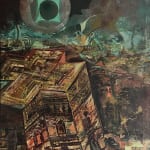

Skunder Boghossian Ethiopian, 1937-2003
39 5/8 x 28 9/16 in
This early work by Skunder Bogossian was painted in 1967. Ten years after having left Ethiopia, Skunder returned home from Paris in 1966. He started teaching at the Addis Fine Art school and travel extensively throughout the country immersing himself in the ancient culture and traditions but also exploring cross cultural African contexts. The present work depicts the dramatic and iconic rock-hewn church Bete Giyorgis or House of St George in Lalibela. The church burned after Imam and General of the Adal Sultanate Ahmad Ibn Ibrahim al-Ghazi (Also known as Ahmad Gragn, the left-handed) defeated the Ethiopian Emperor Dawit II in 1531. The composition is striking at first glance for its seemingly unusual perspective. The burning church dominates the canvas and seems to be tilted to the left as though the viewer is looking down on it. Burning orange, red and yellow, the sharp angles of the cross form of the church are accentuated. A huge moon illuminates the dark ominous sky, lighting up the swirling turquoise and green clouds. What appears at first glance a surreal perspective is in fact accurate, as the Church of St George is hewn out of solid rock directly into the sloping hill. This spectacularly located church has been a religious icon for centuries and thousands of pilgrims flock to it every year.
Skunder Boghossian was born in 1937 during the Italian occupation of Ethiopia, to an Ethiopian mother and a father of Armenian descent. He is widely believed to be one of the founders of Ethiopian Modernism. In 1955 he went to London where he attended St Martins School of Art and Central School of Arts and Crafts, and then shortly after he moved to Paris in 1955/56 to begin at the Ecole des Beaux Arts, shortly after which he transferred to the Académie de la Grande Chaumire. Here he met Curt Coetz, Master of the Studio and André Breton. These, along with other Surrealist artists he met there, would have a substantial impact on him. Skunder submerged himself in African Mythology, symbolism and iconography, developing a strong connection with spiritual powers of African ancestors which would be a source of inspiration for the rest of his life. It is what drew him initially to Surrealism and the representation of the subconscious. In 1965 MoMA purchased his work and he became the first African artist in their collection. Works of this period can be found in numerous other significant collections in the US and France[1].
After spending a decade in Europe Skunder returned to Ethiopia in 1966. While teaching at the Addis Fine Art school, he also travelled extensively throughout the country, immersing himself in the old cultures and traditions but also exploring cross cultural African contexts. At this time he developed an obsession with Magical scrolls made by Debteras which would feature heavily in his later work.
Boghossian explains his own works in the following words: “In all my work, colour is never a mere simulacrum of nature, but it is used to illuminate, to create super-imposed dimensions of form and shape, which in turn enables the viewer to first see the painting as a unit, then as a simultaneous breaking up of images, and finally as a recognition of the identities, for vision has no contour. Each viewer may see this as an endless number of images according to his individual disposition; the images seen one day may have intermingled to form new images the next day, or even to have silently disappeared.”
In 1969 he left Addis Ababa for the United States. From the start he actively participated with the civil rights movement. He joined the staff of Howard University in 1972 at the height of the Black Power Movement and actively participated in a culture of resistance, teaching painting alongside Jeff Donaldson, the founder of the Afri-Cobra movement[2]. Skunder was drawn to the Africentric aesthetic vision that was designed to create imagery that reflects social responsibility and technical excellence.[3] In his work he commented on social injustice and the black consciousness interwoven with references to African heritage and culture. Typical for his work in this period is his experimentation with animal skins and bark cloth, a material used in East African Burials. Even though Skunder had left Ethiopia before the revolution he was still very troubled by what he saw happening to his country and his people. Some of his most powerful work was made as a reaction to events surrounding revolution and the Red Terror in 1974 when a military Junta overthrew the Imperial regime of Emperor Haile Selassie. A gruesome military rule followed ending in 1991 during which time many Ethiopians fled the country. His work is fuelled with repression and occasional misery but an underlying sense of redemption cannot be ignored. Skunder never returned to his home in Ethiopia and stayed in the US until his death in 2003. Nonetheless he left a huge mark on Ethiopian modernism and continues to be an inspiration for many Ethiopian artists within the country and diaspora.
This website uses cookies
This site uses cookies to help make it more useful to you. Please contact us to find out more about our Cookie Policy.
Join the mailing list
* denotes required fields
We will process the personal data you have supplied in accordance with our privacy policy (available on request). You can unsubscribe or change your preferences at any time by clicking the link in our emails.



